So you recently delivered your baby and want to get back into exercise.
But your doctor told you to take it easy for six weeks.
Why? What’s the big deal?
Returning to an exercise routine too soon postpartum can lead to several complications. These include delayed wound healing, pelvic floor dysfunction, diastasis recti, and skeletal injuries.
You can reduce your risk of developing these postpartum issues by following a few key steps.
Let’s review each of the seven risks in more detail and explain what to do instead.
1. Delayed Wound Healing
Many women will experience some type of wound after a delivery. The most common wounds include
- c-section incision
- vaginal laceration
- episiotomy
It is important that you let any wound heal before jumping back into an exercise routine.
Otherwise, they can re-open or become infected, setting you back even more.
How long does it take for a C-Section wound to heal?
It takes at least six weeks for a C-section wound to heal. With that said, your healing time will vary depending on your age, health, and the size of your incision.
Any complications during or after the surgery can also prolong the healing time.
Why does it take so long?
C-section recovery takes at least six weeks because several layers of tissue get cut to get the baby out.
Each layer needs to heal, and it doesn’t happen overnight.
Of all the layers cut, the fascia is the most important.
The fascia is the connective tissue that wraps around your organs and muscles. It helps provide support to your body and protect it from injury.
If the fascia doesn’t heal all the way, exercise can lead to an incisional hernia.
A hernia is when a loop of your small intestine pokes through a hole or a defect in the fascia. Symptoms include a bulge in your abdomen, pain, and nausea.
In the best-case scenario, you live with the bulge, and it causes minimal symptoms.
In the worst-case scenario, the hernia can become strangulated, requiring emergency surgery.
What kind of healing is necessary after vaginal delivery?
More than two-thirds of women experience a vaginal laceration during childbirth. In other words, the baby’s head tears the skin and tissue of the vaginal opening.
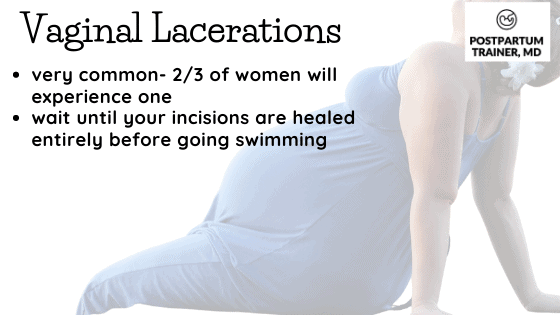
There are four types of lacerations: first-degree, second-degree, third-degree, and fourth-degree.
- First-degree lacerations are very superficial. They often heal by themselves.
- Second-degree lacerations are a little deeper. These need repair through the use of stitches.
- Third-degree lacerations are very deep. They reach your anal sphincter- the outermost part of your anus.
- Fourth-degree lacerations are the most severe. In these cases, your vagina tears all the way through to your rectum. These need extensive repair.
Most women experience a second-degree laceration.
The bigger your baby, the bigger your risk of a more severe laceration. Another reason not to “celebrate” if your baby was born at 10 lbs.
Exercising too soon after a vaginal delivery can cause your stitches to pop open.
How long does it take for a vaginal laceration to heal?
Depending on the depth of the tear, it can take two to three weeks for a vaginal laceration to heal. If you get stitches, they will dissolve in six weeks.
What if you didn’t get any stitches? Good job! You are part of the minority.
What About Episiotomies?
An episiotomy is when your doctor cuts your perineum to make more room for the baby during delivery. (The perineum is the area between your vagina and anus.
These procedures are becoming less common over the years. Back then, it was routine to do them for almost every woman.
If you received an episiotomy, that area will also need time to heal. The last thing you want to happen is for your vaginal wound to open.
The good news is that episiotomies can heal as fast as vaginal lacerations – within two to three weeks.
2. Pelvic Floor Dysfunction
The pelvic floor is a group of muscles that support your bladder, vagina, and rectum. After giving birth, these muscles can weaken from the trauma of the delivery.
Unfortunately, these muscles can become weak after a cesarean delivery as well. (source)
The most common manifestations of a weak pelvic floor include:
- urinary incontinence (aka stress incontinence),
- bladder control issues,
- and even pelvic organ prolapse.
High-impact exercise in the early postpartum can aggravate pelvic muscle weakness.
The good news is that you can do pelvic floor exercises to strengthen these muscles.
More on that later.
3. Worsening Diastasis Recti
Diastasis recti (DR) is a condition where your rectus abdominal muscles separate. The separation occurs at the linea alba, a thin connective between the rectus muscles.
Unfortunately, up to two-thirds of pregnant women will develop the condition. (source)
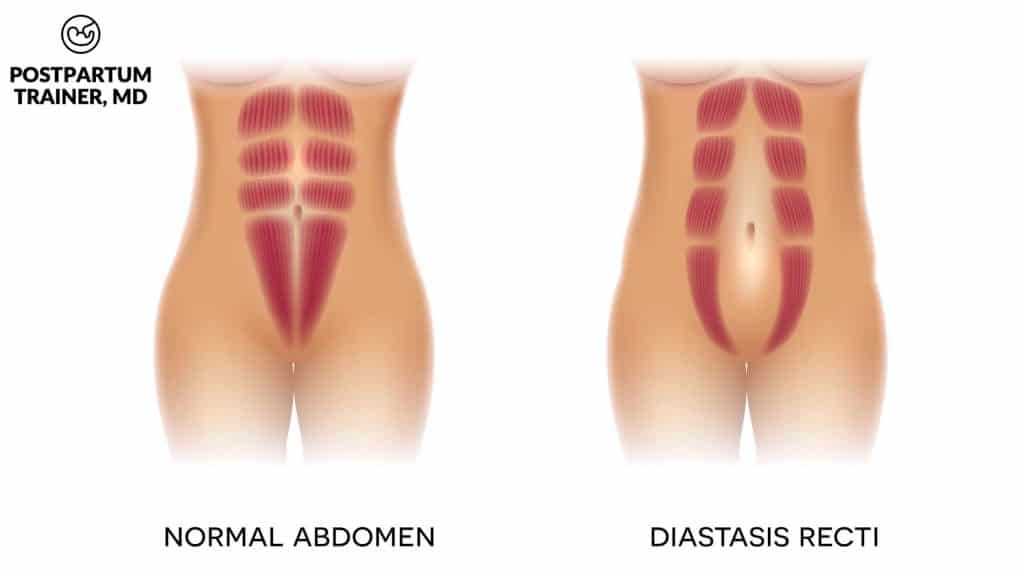
But the good news is that DR can heal on its own over the course of six months. (source)
If you are not careful, certain exercises can place too much demand on your core muscles. Doing so could worsen the condition and exacerbate the separation.
That’s why it’s a good idea to do core DR-safe exercises in the early postpartum.
4. Musculoskeletal Injury
Another risk of starting to exercise too soon is musculoskeletal injury.
Your body goes through a lot of changes during pregnancy.
Do you remember what your hips looked like before you got pregnant?
Can you see how much wider they are now?
Well, that doesn’t happen by magic.
During pregnancy, your body releases a hormone called relaxin. This hormone helps to relax and loosen the ligaments in your hips so that they can expand. Without relaxin, a vaginal birth is not possible.
This happens to your other joints too.
The problem is that these ligaments stay loose for up to 6 months after the baby is born. (source)
Vigorous exercise too soon postpartum can put a lot of extra stress on your joints and lead to injury.
5. Postural Changes
Another thing to consider before you start exercising again is your posture.
As your uterus expands, it causes more weight to redistribute to the front of your body. This extra weight can tilt your pelvis forward, causing “anterior pelvic tilt.”
An anterior pelvic tilt can lead to lower back pain and injury.
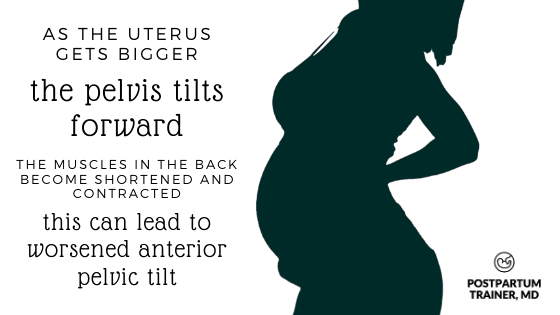
It can also make doing specific exercises that use your glute muscles difficult.
That’s why restoring proper posture is essential before starting an intense exercise program.
Advanced stages of anterior pelvic tilt can be hard to reverse.
A good postpartum workout plan should address these pregnancy-related muscle weaknesses.
Related Post: How to relieve back pain in the postpartum.
6. Postnatal Bleeding
Have you ever heard of the word lochia?
Lochia refers to the discharge that comes out of your uterus after delivery. It is often bloody.
Lochia is normal; your uterus is evacuating everything left over from the pregnancy. In other words, it’s normal to experience bleeding for up to 6 weeks after delivery.
The bleeding should get lighter and lighter as the days go by.
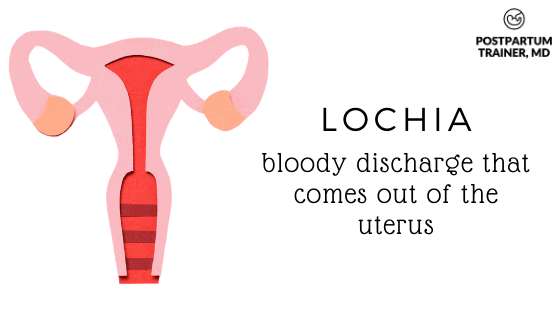
One of the first things your body does after delivery is release a hormone called oxytocin. This hormone has several actions, but one of them is to help your uterus contract.
These contractions close the blood vessels that connect the placenta to your uterus.
Vigorous exercising soon after delivery can interfere with this process.
Why? Because exercise leads to increased blood flow throughout your body.
And can you guess one place that will get a good chunk of that blood flow?
Especially since it’s at least 5x the size as normal?
The uterus.
That’s why physical activity shortly after delivery can lead to heavier bleeding.
You already lose enough blood during the delivery. You don’t need to lose anymore by exercising too soon.
7. You Can Increase The Risk Of Infection
Bacteria is everywhere!
On your skin, on your clothes, in your vagina, and in your sweat.
If you exercise with wounds that haven’t yet healed, you risk letting your sweat get into them.
As nasty as that sounds, getting a wound infection is even worse.
The mildest forms of wound infections can get better with oral antibiotics.
But the worst forms will need an incision and drainage. Yup, that means another procedure for us to re-open the wound and clean it out.
Oh, and we don’t usually close these. They generally need to heal wide open.
Not worth it.
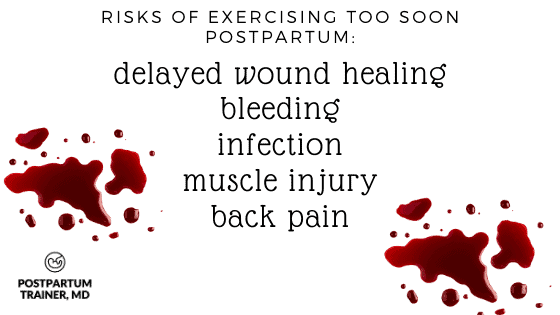
So When Can I Start Exercising Again?
I know that this article sounded scary. But it’s not meant to scare you away from exercising after the baby.
No one knows your body better than you do.
How soon you can exercise after giving birth depends on a few things.
The most critical factors are:
- Your age,
- Recovery,
- Health, and
- Previous fitness levels.
You are likely motivated to exercise sooner if you were active before pregnancy.
Even so, the American College of Obstetricians and Gynecologists (ACOG) has weighed in. They state that some women can begin gentle exercise a few days after delivery.
The key is to start with simple movement patterns focusing on a few key areas. These include restoring core strength, pelvic muscles, and postural alignment.
Postnatal stretching is another great way to become active in the postpartum period.
Once you’re ready to start exercising again, check out my Guide to Getting Fit after Pregnancy.
Always start low and go slow.
Stay hydrated.
And listen to your body.
If something starts to hurt or you notice heavy bleeding, then stop.
Always check with your doctor or health care provider and stay on top of your postnatal care.
Final Thoughts
To wrap it all up:
Many changes happen to your body during pregnancy and during the postpartum period.
Whether you had a C-section or not, your body needs time to heal.
Go slow, and reintroduce light exercise activities one at a time.
Start by strengthening the pelvic floor muscles and doing gentle core work.
Don’t compare your recovery time to anyone else.
We are all different, and healing takes time.
Always check with your doctor to get clearance before exercising.
Now I want to hear from you.
How long did you wait after your delivery to do regular exercise?
Did you experience any of these complications?
Other Posts Related to Postpartum Exercises
- The Top 3 Things You Must Avoid After Giving Birth
- How To Exercise Before 6 weeks Postpartum
- When Can You Lift Heavy Weights After Having a Baby?
- The Best Postpartum Exercise For New Moms

Get Four Free Workouts To Help Strengthen Your Pelvic Floor & Heal Your Mommy Tummy!

Brittany Robles, MD, MPH, CPT
Brittany Robles is a full-time OBGYN physician, a NASM certified trainer, and a prenatal and postnatal fitness specialist. She holds a Master of Public Health degree in maternal health with a special interest in exercise and nutrition. She is also the co-author of The White Coat Trainer. Learn more about her here.
Sharing is Caring – Send This To A Mom In Need!
References:
- Samuelsson E, Ladfors L, Lindblom BG, Hagberg H. A prospective observational study on tears during vaginal delivery: occurrences and risk factors. Acta Obstet Gynecol Scand. 2002 Jan;81(1):44-9. doi: 10.1046/j.0001-6349.2001.10182.x. PMID: 11942886.
- Rortveit G, Daltveit AK, Hannestad YS, Hunskaar S; Norwegian EPINCONT Study. Urinary incontinence after vaginal delivery or cesarean section. N Engl J Med. 2003 Mar 6;348(10):900-7. doi: 10.1056/NEJMoa021788. PMID: 12621134.
- Sperstad JB, Tennfjord MK, Hilde G, Ellström-Engh M, Bø K. Diastasis recti abdominis during pregnancy and 12 months after childbirth: prevalence, risk factors and report of lumbopelvic pain. Br J Sports Med. 2016 Sep;50(17):1092-6. doi: 10.1136/bjsports-2016-096065. Epub 2016 Jun 20. PMID: 27324871; PMCID: PMC5013086.
- Fernandes da Mota PG, Pascoal AG, Carita AI, Bø K. Prevalence and risk factors of diastasis recti abdominis from late pregnancy to 6 months postpartum, and relationship with lumbo-pelvic pain. Man Ther. 2015 Feb;20(1):200-5. doi: 10.1016/j.math.2014.09.002. Epub 2014 Sep 19. PMID: 25282439.
- Afshar A, Tabrizi A. Pregnancy-related Hand and Wrist Problems. Arch Bone Jt Surg. 2021 May;9(3):345-349. doi: 10.22038/abjs.2020.50995.2531. PMID: 34239963; PMCID: PMC8221449.

I waited 6 days. Any more than that and I would have gone insane. And stretching/ body weight is boring and uninspiring. Since I had an episiotomy I stuck to my normal tricep and shoulder routines with no lower body, but I did challenge myself. It felt great. I bled a bit more (lochia , not the stitches) but it was worth it 1000% for my mental health). If I had had to wait any longer or have “taken it easy” I’d have gone insane. I’m 2 weeks pp today and am 3 workouts in and am thinking of adding in some light legs/Glutes and back this week.
Hi Erin,
Thank you so much for your comment and for sharing your story!